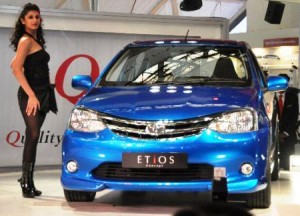India is expected to grow into one of the auto industry’s superpowers during the next decade, according to a new report by J.D. Power & Associates – and is likely to become the world’s third-largest automotive market by 2020.
The new study, “India Automotive 2020: The Next Giant from Asia,” noted that the vast subcontinental market already surpassed France, the United Kingdom and Italy to become the sixth-largest automotive market in the world in 2010. More than 2.7 million light vehicles were sold in India in 2010, up from just 700,000 a decade earlier.
By 2020, the report projected, India’s automotive volume will grow to 11 million, positioning the nation of 1.2 billion just behind China, with projected annual sales of 35 million units in 2020, and the U.S., where light vehicles sales are pegged to reach 17.4 million.
“India has quickly become one of the largest and fastest-growing automotive markets in the world,” said John Humphrey, senior vice president of global automotive operations at J.D. Power and Associates.
“This momentum has been driven by a more open and market-driven economy, an empowered and less risk-averse work force, a more consumer-driven culture and an emphasis on small car production,” he added.
Overall, India’s government has pursued policies supportive of India’s fledgling automotive industry, helping position the country as a global hub for small passenger car production, Humphrey said.
As a result, many automakers are shifting operations to India, or designing vehicles specifically to fit Indian market needs.
In 2010, nearly 80% of all new passenger vehicles sold in India were classified as either minicars or subcompacts. By comparison, those small car segments accounted for only 24% of passenger-vehicle sales in China in 2010, and just 3% of passenger-vehicle sales in the United States.
The average transaction price for all new passenger vehicles sold in 2010 in India was about $10,000 – compared with $17,500 in China and $28,000 in the United States. The best-selling passenger car in India–the Maruti Suzuki Alto–had an average transaction price of about $6,200. And the rock-bottom Tata Nano can be purchased for barely $3,000.
While India’s emphasis on small vehicles has helped sales grow, it also means that automaker earnings will depend primarily on downsized segments where profit margins are traditionally thin, Humphrey cautioned.
“Should fuel prices continue to climb globally in the future–and as demand for inexpensive and reliable transportation increases in many of the world’s developing markets–India could find itself well-positioned to fulfill the needs of the small car segment,” said Humphrey.
“That said, profit margins are thinner in the small car segment, so automakers are going to need to manage their businesses carefully to optimize profits,” he said.
While significant progress has been made in building the Indian automotive industry, there are challenges that could impede India from reaching its future potential.
In India, government, business and academic officials regularly refer to India’s “three deficits” as reasons for caution about the automotive market’s future growth:
- Continual international trade deficits;
- Chronic government budget deficits; and
- An underdeveloped power generation and distribution infrastructure.
While India’s recurring budget and trade deficits forced the country to liberalize its economy and industries in the early 1990s, the lagging infrastructure poses the biggest potential obstacle to the expansion of the automotive market.
“Much of India’s future growth in the automotive sector will depend on successfully creating the infrastructure to support its economy,” said Humphrey.
India also lacks a broad-based automotive components and parts production industry, as well as the engineering talent needed to carry the automotive components industry forward.
“Right now, much of the industry still depends on smaller local parts makers to produce components for vehicles,” said Humphrey. “For India to build vehicles of high quality, and in large volumes–especially for export–significant improvements to the components industry will need to be made,” Humphrey said.

